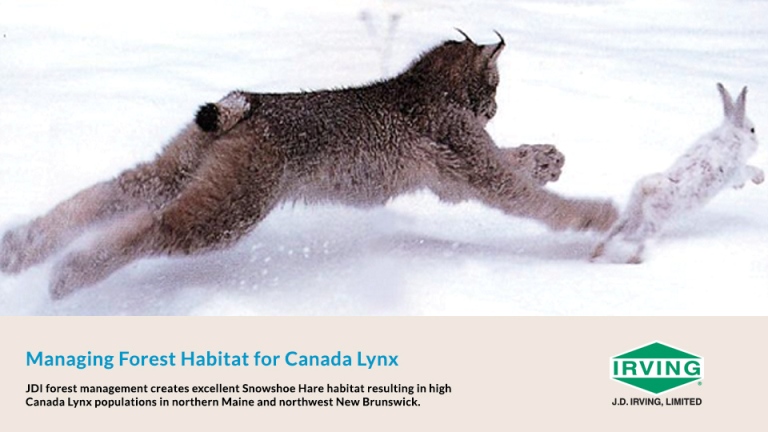Managing Forest Habitat for Snowshoe Hare and Canada Lynx
Watch our video with JDI wildlife biologist John Gilbert on the connection between excellent Snowshoe hare habitat and improved Canada lynx populations in northern Maine and northwest New Brunswick. Vimeo YouTube
Sustainable forest practices across JDI-managed lands in northern Maine and northwest New Brunswick has led to a significant increase in the Snowshoe hare population – a major source of food for the Canada lynx.
“The best snowshoe hare habitat is young, naturally regenerating softwood and mixed wood forests between 8 and 20 years old, and 5-to 10-year-old planted conifer stands,” said John Gilbert, Manager of Fisheries and Wildlife with JDI. “An increased Snowshoe hare population is good for the Canada lynx. Hare make up to 90 percent of the lynx's diet, so you can see the connection.”

The US Fish and Wildlife Service is currently doing a five-year status update on the Canada lynx population. Based on JDI-sponsored studies with the University of Maine in the early 2000s and today’s reporting by our field staff in northern Maine and northwestern New Brunswick, lynx populations have never been higher in recent history.
“Our staff and contractors are seeing many instances of lynx tracks as well as lynx sightings on almost a weekly basis,” said John Gilbert. “This gives us great evidence that the lynx populations are thriving in a managed forest environment.”
Managing for Canada lynx involves a landscape-level approach. Areas of young regenerating forest, which provide excellent habitat for Snowshoe hare (the food), are coupled with older forests. The nearby older forests are found in riparian zones and areas provided by JDI’s old forest policy, providing quality lynx den sites (the shelter) under older blown-down trees.
JDI’s award-winning Unique Areas conservation program protects over 1,155 sites (78,976 Hectares) for birds and mammals; fish, lakes, and wetlands; plants; reptiles; and invertebrates. In addition, the company maintains 48,434 Hectares of designated old forest within its working forest landscape.